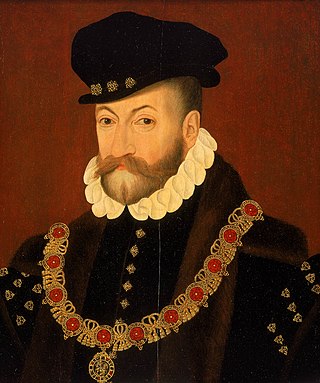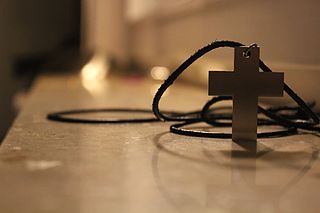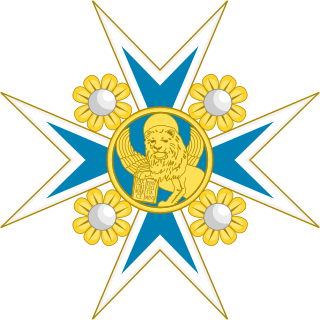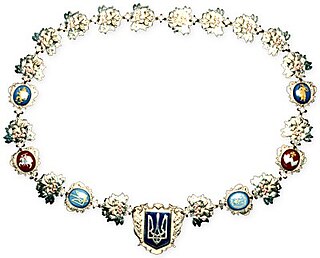
The Most Excellent Order of the British Empire is a British order of chivalry, rewarding contributions to the arts and sciences, work with charitable and welfare organisations, and public service outside the civil service. It was established on 4 June 1917 by King George V and comprises five classes across both civil and military divisions, the most senior two of which make the recipient either a knight if male or dame if female. There is also the related British Empire Medal, whose recipients are affiliated with, but not members of, the order.

A pendant is a loose-hanging piece of jewellery, generally attached by a small loop to a necklace, which may be known as a "pendant necklace". A pendant earring is an earring with a piece hanging down. Its name stems from the Latin word pendere and Old French word pendr, both of which translate to "to hang down". In modern French, pendant is the gerund form of pendre and also means "during". The extent to which the design of a pendant can be incorporated into an overall necklace makes it not always accurate to treat them as separate items.

A necklace is an article of jewellery that is worn around the neck. Necklaces may have been one of the earliest types of adornment worn by humans. They often serve ceremonial, religious, magical, or funerary purposes and are also used as symbols of wealth and status, given that they are commonly made of precious metals and stones.

The Royal Victorian Order is a dynastic order of knighthood established in 1896 by Queen Victoria. It recognises distinguished personal service to the monarch, members of the royal family, or to any viceroy or senior representative of the monarch. The present monarch, King Charles III, is the sovereign of the order. The order's motto is Victoria. The order's official day is 20 June. The order's chapel is the Savoy Chapel in London.

A choker is a close-fitting necklace worn around the neck, typically 14 inch to 16 inch in length. Chokers can be made of a variety of materials, including velvet, plastic, beads, latex, leather, metal, such as silver, gold, or platinum, etc. They can be adorned in a variety of ways, including with sequins, studs, or a pendant.
A dog collar is a piece of material put around the neck of a dog. A collar may be used for restraint, identification, fashion, protection, or training. Identification tags and medical information are often placed on dog collars. Collars are often used in conjunction with a leash for restraining a dog. Collars can be traumatic to the trachea if the dog pulls against the restraint of the leash, causing severe pressure to the neck. Use of a harness instead of a collar may be beneficial for dogs prone to tracheitis or those with a collapsed trachea. Conversely, dog breeds with slender necks or smaller heads may easily slip out of collars that are too loose. This can be avoided by using a martingale dog collar which tightens to distribute pressure around the neck when training the dog not to pull. Any style of dog collar must be properly fitted to ensure safety and collars should not be worn when the dog is unattended.

The Royal Order of the Seraphim is a Swedish order of chivalry created by King Frederick I on 23 February 1748, together with the Order of the Sword and the Order of the Polar Star. The order has only one class with the dignity of Knight, and is the foremost order of Sweden.

A livery collar or chain of office is a collar or heavy chain, usually of gold, worn as insignia of office or a mark of fealty or other association in Europe from the Middle Ages onwards.
Collar days are designated days on which the collar forming part of the insignia of certain members of British orders of knighthood may be worn.

The Order of Pope Pius IX, also referred as the Pian Order, is a papal order of knighthood originally founded by Pope Pius IV in 1560. Currently, it is the highest honor conferred by the Holy See. The awarding of the order fell into disuse and was re-instituted by Pope Pius IX as a continuation on 17 June 1847.

A collar, also known as collar of an order, is an ornate chain, often made of gold and enamel, and set with precious stones, which is worn about the neck as a symbol of membership in various chivalric orders. It is a particular form of the livery collar, the grandest form of the widespread phenomenon of livery in the Middle Ages and Early Modern Period. Orders which have several grades often reserve the collar for the highest grade. The links of the chain are usually composed of symbols of the order, and the badge of the order normally hangs down in front. Sometimes the badge is referred to by what is depicted on it; for instance, the badge that hangs from the chain of the Order of the Garter is referred to as "the George".

As early as the Old Kingdom, Egyptian artisans fashioned images of deities, kings, and mortals wearing broad collars made of molded tubular and teardrop beads. The Usekh or Wesekh is a personal ornament, a type of broad collar or necklace, familiar to many because of its presence in images of the ancient Egyptian elite. Deities, women, and men were depicted wearing this jewelry. One example can be seen on the famous gold mask of Tutankhamun. The ancient word wsẖ can mean "breadth" or "width" in the Ancient Egyptian language and so this adornment is often referred to as the broad collar.

The Patiala Necklace was a necklace designed and made by Cartier in 1928. It was part of the largest ever single order to Cartier to date, made in 1925 by the Indian royalty, the Maharaja of Patiala, for the Patiala Necklace and other jewelry worth ₹1,000 million.

A cross necklace is any necklace featuring a Christian cross or crucifix.

The Order of Saint Mark was the sole order of chivalry of the Republic of Venice. It was named in honour of Venice's patron saint, Mark the Evangelist.

The sign (collar) of the President of Ukraine weighs about 400 grams. The president's collar is not obligatory, but most European heads of state have such a decoration: for instance, the president's collar is one of the symbols of state power in Bulgaria and Poland. Some countries grant another collar to the new head of the state, and the previous one passes to the national museums. An open-work chain with a historical relic – an amulet which, as the legend reads, belonged to Ukrainian Hetman Ivan Mazepa – was among the attributes of the President of Ukraine in exile.
Nelson Chung, known professionally as Onch Movement, is a Taiwanese American jewelry designer and television personality. Onch appeared on Season 1 of Paris Hilton's My New BFF, and co-hosted Season 2. Onch Movement's jewelry is known for food-themed accessories, as well as jewelry based on licensed products such as My Little Pony, Mr. Potato Head, and Hello Kitty.

A rivière is a necklace consisting of one or more strings of linked gemstones. Usually only one kind of gemstone is used in a rivière, with all stones of the same colour and cut. The stones are either all the same size, or gradually increase in size towards the middle of the necklace. Rivières have been worn since the 18th century and are still a popular type of necklace.

The Collar of Honour is a state decoration of Sudan established in 1956 after Sudan independence. The collar is awarded to the Head of state of Sudan and foreign countries.
















